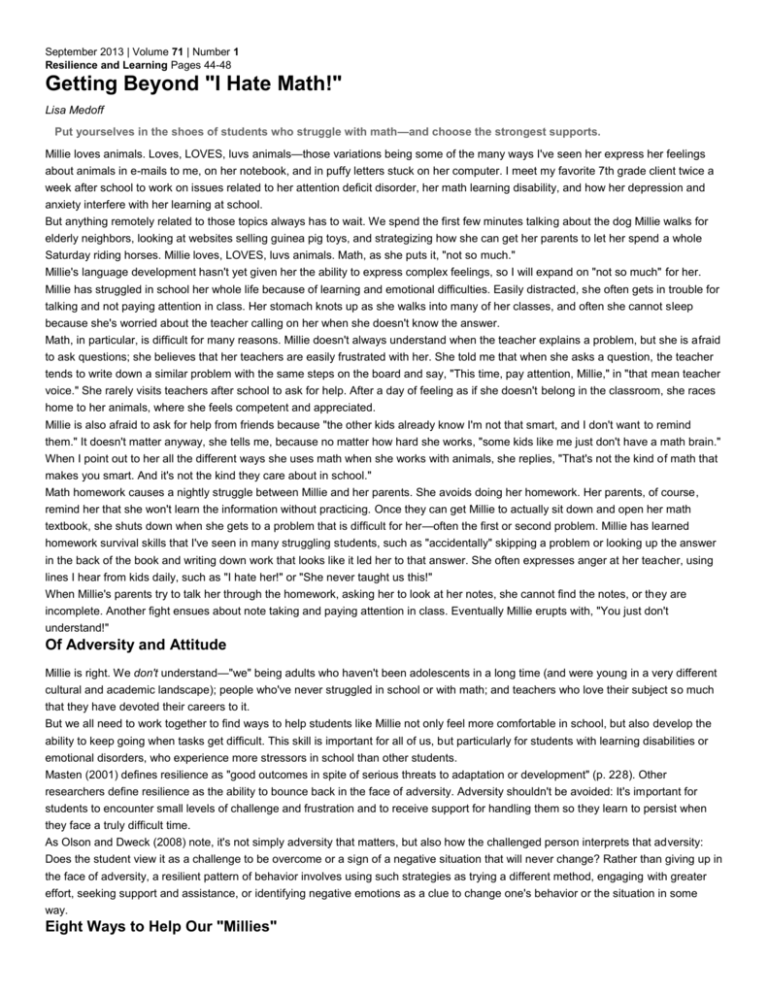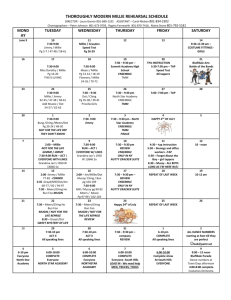Getting Beyond, "I Hate Math!"
advertisement

September 2013 | Volume 71 | Number 1 Resilience and Learning Pages 44-48 Getting Beyond "I Hate Math!" Lisa Medoff Put yourselves in the shoes of students who struggle with math—and choose the strongest supports. Millie loves animals. Loves, LOVES, luvs animals—those variations being some of the many ways I've seen her express her feelings about animals in e-mails to me, on her notebook, and in puffy letters stuck on her computer. I meet my favorite 7th grade client twice a week after school to work on issues related to her attention deficit disorder, her math learning disability, and how her depression and anxiety interfere with her learning at school. But anything remotely related to those topics always has to wait. We spend the first few minutes talking about the dog Millie walks for elderly neighbors, looking at websites selling guinea pig toys, and strategizing how she can get her parents to let her spend a whole Saturday riding horses. Millie loves, LOVES, luvs animals. Math, as she puts it, "not so much." Millie's language development hasn't yet given her the ability to express complex feelings, so I will expand on "not so much" for her. Millie has struggled in school her whole life because of learning and emotional difficulties. Easily distracted, she often gets in trouble for talking and not paying attention in class. Her stomach knots up as she walks into many of her classes, and often she cannot sleep because she's worried about the teacher calling on her when she doesn't know the answer. Math, in particular, is difficult for many reasons. Millie doesn't always understand when the teacher explains a problem, but she is afraid to ask questions; she believes that her teachers are easily frustrated with her. She told me that when she asks a question, the teacher tends to write down a similar problem with the same steps on the board and say, "This time, pay attention, Millie," in "that mean teacher voice." She rarely visits teachers after school to ask for help. After a day of feeling as if she doesn't belong in the classroom, she races home to her animals, where she feels competent and appreciated. Millie is also afraid to ask for help from friends because "the other kids already know I'm not that smart, and I don't want to remind them." It doesn't matter anyway, she tells me, because no matter how hard she works, "some kids like me just don't have a math brain." When I point out to her all the different ways she uses math when she works with animals, she replies, "That's not the kind of math that makes you smart. And it's not the kind they care about in school." Math homework causes a nightly struggle between Millie and her parents. She avoids doing her homework. Her parents, of course, remind her that she won't learn the information without practicing. Once they can get Millie to actually sit down and open her math textbook, she shuts down when she gets to a problem that is difficult for her—often the first or second problem. Millie has learned homework survival skills that I've seen in many struggling students, such as "accidentally" skipping a problem or looking up the answer in the back of the book and writing down work that looks like it led her to that answer. She often expresses anger at her teacher, using lines I hear from kids daily, such as "I hate her!" or "She never taught us this!" When Millie's parents try to talk her through the homework, asking her to look at her notes, she cannot find the notes, or they are incomplete. Another fight ensues about note taking and paying attention in class. Eventually Millie erupts with, "You just don't understand!" Of Adversity and Attitude Millie is right. We don't understand—"we" being adults who haven't been adolescents in a long time (and were young in a very different cultural and academic landscape); people who've never struggled in school or with math; and teachers who love their subject so much that they have devoted their careers to it. But we all need to work together to find ways to help students like Millie not only feel more comfortable in school, but also develop the ability to keep going when tasks get difficult. This skill is important for all of us, but particularly for students with learning disabilities or emotional disorders, who experience more stressors in school than other students. Masten (2001) defines resilience as "good outcomes in spite of serious threats to adaptation or development" (p. 228). Other researchers define resilience as the ability to bounce back in the face of adversity. Adversity shouldn't be avoided: It's important for students to encounter small levels of challenge and frustration and to receive support for handling them so they learn to persist when they face a truly difficult time. As Olson and Dweck (2008) note, it's not simply adversity that matters, but also how the challenged person interprets that adversity: Does the student view it as a challenge to be overcome or a sign of a negative situation that will never change? Rather than giving up in the face of adversity, a resilient pattern of behavior involves using such strategies as trying a different method, engaging with greater effort, seeking support and assistance, or identifying negative emotions as a clue to change one's behavior or the situation in some way. Eight Ways to Help Our "Millies" The following strategies help foster resilience in students like Millie. Not every strategy will be the right match for every student or teacher; experiment to find the ones that work for you. If you've tried a particular action or way of talking with your struggler for a few weeks and it hasn't changed his or her behavior, try another. 1. Empathize. Remind yourself to have empathy for students who struggle with math. Math teachers often excelled in math at school: It seemed easy to learn, they felt comfortable in the math classroom, and they enjoyed working out difficult problems. If math came easily to you, try to put yourself in the student's place by imagining how you feel when you're trying to learn something that is completely out of your comfort zone. What do you need from others to learn this information? What's the best environmental set-up for you? How do you need others to speak to you? What do you say to yourself to calm the anger and frustration that arise? Imagine what it feels like for students to be in your classroom. Envision yourself as a variety of kids, especially those clearly in deep water in math. What feelings, fears, and anticipations might arise? How would it feel to sit at a desk during a lecture or a group math activity? To take an exam? What is that child's home life like, and how does that affect his or her homework? Think about how you could adjust your classroom environment, instruction, and assignments to help individuals feel more confident. You can probably see strengths in each student that he or she draws on to demonstrate resilience in other areas of life. How could you draw out those strengths in math work? You might help students connect how they persevere in another area with what they need to do in math: "Alice, what do you do when you keep forgetting lines when rehearsing for a play? What part of that strategy might work in math?" A teacher's ability to make connections to other areas of a student's life that the student is passionate about is crucial. 2. Solidify your own understandings. I sometimes observe teachers who aren't comfortable teaching a certain math concept, perhaps because it's a new concept or method or because the teacher doesn't consider math his or her strength. He or she may rush through an explanation before the students can ask questions—questions the teacher isn't prepared to answer. Or a teacher's insecurity with the material might come out as anger or frustration with students who ask questions. Teachers sometimes try to connect with students—and mask their discomfort with the material—by making statements such as, "I don't really like this either, but we're required to learn it, so let's just get through this." Although I understand that teachers are incredibly pressed for time, it's vitally important that they learn the material thoroughly so they are in a place to welcome questions. Students benefit when teachers model how they learned a concept, even if those teachers aren't totally comfortable with it yet. They can show students how they talk through their own self-doubts and frustrations and persist in their quest to learn new things. 3. Use a variety of activities and supports. Many students, especially math strugglers, become anxious when they have to take notes from a teacher's lecture. They worry about keeping up and being called on without warning. Group work and hands-on learning can reduce their anxiety. Unfortunately, many classrooms have a culture of competition; students compete for praise and attention from the teacher, which often go to the student who can give the correct answer most quickly. During group work, the teacher can direct instruction and support where it's most needed and spend more time with individual students to figure out where they've gotten lost. Students are less likely to disrupt to get the teacher's attention. In addition, students can help one another. Strugglers get an opportunity to ask questions in a low-pressure environment. They might receive explanations personally tailored to what they want to know because a peer can sometimes see more clearly than the teacher what a fellow student doesn't understand. Learners often feel more comfortable taking risks and trying new things in small groups, especially when they have time to process new material. You'll need to set up supportive conditions for group work to serve students like Millie. Give clear directions about what you expect from group work, and assign each student a role (such as recorder, reporter, or the one who monitors that everyone is contributing). It's helpful to write out what each role entails and how it interacts with other roles (for instance, the recorder ensures that the reporter can understand what's written down) and to post these descriptions. Written sentence stems (such as "I understood up to ___, but I got lost at this point: __") can guide students in asking specific questions about what they don't comprehend or helping peers without giving them the answer. Learning how to guide peers is an incredibly important skill. Teach students to say things like, "Tell me where you got stuck," and "Let's start with what you know about this problem." I sometimes tell kids I will do the first few problems with them by taking turns—I do one step, they do the next, and so on. I let them decide if they want to go first or second, and we talk each other through what we're doing. This type of scaffolding makes the problem more social and less threatening. Teach students this strategy for assisting one another. Select tasks deliberately. Choose activities or problems with several possible solutions and steps to deriving those solutions to promote the idea that there are many ways to be "smart" in math. Select problems that relate to the students' current lives. It's important, especially in middle school, to make tasks concrete and related to the present, rather than to a possible future. For instance, a task related to music or other forms of media will be easier to relate to than one that involves adult career options. Provide students with manipulatives, calculators, or technology (if available) for experimenting or for recording the process. Allow kids time and space to be as physically active as possible. 4. Tune in to how you talk about math. Make sure to approach the topic with a growth mind-set that emphasizes that intelligence is changeable. Carol Dweck and colleagues (2006) have found that students who believe intelligence is fixed tend to interpret challenges as a sign that they are "dumb"—or that they might be seen as such. This compromises resilience, even among students with a history of high achievement (Nussbaum & Dweck, 2008). Make clear through your words and behaviors that you believe that everyone can learn math by putting in the effort. Say things like, "Some kids may need to put in more effort in certain areas than others do. And each of you needs to approach a set of problems a bit differently. But every one of you can master this math." 5. Answer all questions respectfully. Even if you've answered a question before, don't reprimand the asker or show impatience. Children and adolescents often need repetition to really learn a concept. Say, "That's a very insightful question," or "I'm glad you asked me again to make sure you understood." 6. Be intentional about homework. Ask yourself, How many problems will students really need to do for practice? What types of problems will help them consolidate and remember what they've learned? Think about what might happen when a student with weak skills brings home 20 problems. Will the student have someone available to help if he or she gets stuck? If not, what resources can you provide? Have students write down steps for what to do when they get frustrated, and talk about working through frustration as a vital part of learning new concepts. Reinforce this notion when reviewing students' homework by having students tell you about problems on which they got stuck—and how they got through the difficulty. 7. Reframe the purpose of quizzes and tests. Anxiety about the larger meaning of assessments can interfere with performance. Make it clear to students that tests are not meant to determine how smart a student is, but to show the teacher how well he or she taught the information—and to show the test taker what he or he has and hasn't learned yet. Avoid giving scores on all tests; instead, give students feedback on the problem-solving steps they've tried. Consider giving students choices on exams, such as the choice between two similar problems with different numbers or a choice between a more and a less complex problem that taps the same understandings. I find that even if a struggling student like Millie feels prepared for an exam, encountering one problem that she cannot do often makes her anxious and throws her off for the entire exam. Having options provides a sense of control and encourages a test taker to persist and try each required item, rather than skipping some problems. 8. Praise effort and reinterpret mistakes. Teacher praise can lead to less resilient patterns of behavior (Mueller & Dweck, 1998). If you help children learn to praise themselves for persisting with a difficult task, they should come to attribute success to hard work, rather than to being "smart." Involve students in defining what constitutes success on a particular assignment, such as by designing the rubric with them, and in evaluating finished work. Teach them to identify their own successes. Consistently give the message that mistakes are merely a sign that the problem must be approached differently, not a sign of low intelligence or skills. Be vigilant about students' reactions to others' mistakes. Never use sarcasm or a harsh tone in response to a wrong answer, even if you think the students know you're joking. And make sure you accept correction gracefully when you err— emphasizing that now you've learned something new. Catching On I've used many of these strategies with Millie. She is slowly shifting her perception of herself and her ability to succeed in both math and school in general. She's more willing to engage with homework problems that look difficult, and she'll check her notes or the teacher's website when she gets stuck on a problem. I see her starting to reframe her test and quiz scores for herself, noting that she didn't study that particular type of problem, rather than throwing the test down and saying, "My teacher hates me!" I recently asked Millie what she does when she's training a dog that doesn't learn new behavior right away. She explained, "I know it's not his fault. His owners probably let him get away with a lot of sloppy behaviors for a long time. I try different types of reinforcements, and I'm really patient with him. I know he'll get it eventually." She went on, explaining various things she would try because every dog has a different personality, experiences, and fears. Finally she asked, "Hey, why are you letting me talk about dogs so much when we're supposed to be talking about my math test?" I smiled and waited until Millie caught on to the similarities—and the role of patience—in both learning scenarios. "So does it still feel like you just don't have a math brain?" She smiled back. "Not so much." I loved, LOVED, luved that response. Author's note: "Millie" is a pseudonym. References Dweck, C. S. (2006). Mindset. New York: Random House. Masten, A. (2001). Ordinary magic: Resilience processes in development. American Psychologist, 56, 227–238. Mueller, C. M., & Dweck, C. S. (1998). Praise for intelligence can undermine children's motivation and performance. Journal of Personality and Social Psychology, 75, 33–52. Nussbaum, A. D., & Dweck, C. S. (2008). Defensiveness vs. remediation: Self-theories and modes of self-esteem maintenance. Personality and Social Psychology Bulletin, 34, 127–134. Olson, K., & Dweck, C. S. (2008). A blueprint for social cognitive development. Perspectives on Psychological Science, 3, 193– 202. Lisa Medoff teaches in the Program in Human Biology and the School of Education at Stanford University. She is the author of Resilience in the Classroom: Helping Students with Special Needs (Kaplan, 2010).











